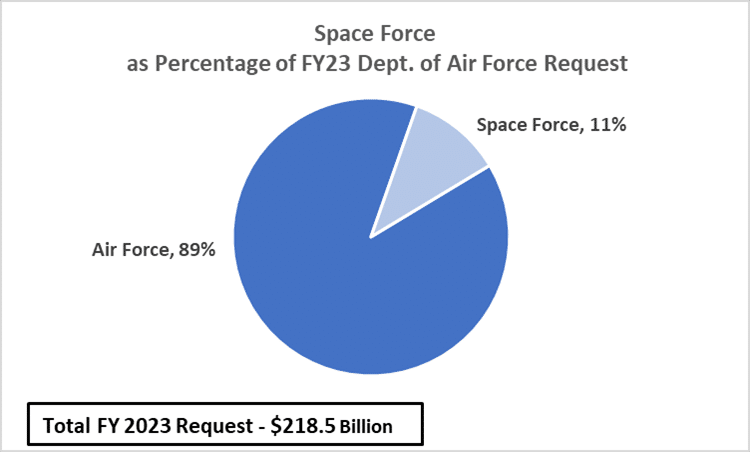For those of you new to Space Force, which was created in 2019, it’s the first new military service formed in over 70 years. The last time a service was created, it was the Air Force (Original Recipe) created from the old U. S. Army Air Forces after World War II. Now the Department of the Air Force includes two military services: Air Force and Space Force. This follows the structural pattern of the Department of the Navy which also includes two military services: the Navy and Marine Corps.
The Biden Administration is requesting $24.5 billion for Space Force in FY 2023, roughly 40 percent more than was requested in FY 2022. But it’s important to note that much of this may not actually be “new” money, but instead represents the ongoing transfer of programs from the Air Force into Space Force. The Air Force budget documents call out that $3 billion of the increase is for inter-service transfers, the remaining $4.1 billion is for actual programmatic growth.
For example, the proposed 200 person increase in Space Force’s requested FY 2023 end strength of 8,600 military and civilian personnel is the result of interservice transfers as the Pentagon continues to consolidate missions under the new service. In FY 2023 this includes the transfer of the Space Development Agency from the Air Force. The total Personnel budget request for Space Force in FY 2023 is $1.1 billion (Pentagon documents don’t provide a prior year figure for comparison).
The largest component of the Space Force budget is for Research and Development. The FY 2023 request is for $15.8 billion, almost 40 percent above last year’s $11.3 billion request. But again, it’s difficult to determine how much of this is new funding. This includes almost $3.5 billion for the Next-Generation Overhead Persistent Infrared (OPIR) system (a 42 percent increase) and just over $1 billion for the new Resilient Missile Warning/Missile Tracking program.
The Space Force request also includes $4.0 billion for Operations & Maintenance (an increase of almost 18 percent over last year’s request) and $3.6 billion for Procurement (up over 28 percent).
As TCS readers have probably already realized, it’s a chaotic budget year for the Pentagon, and particularly for the fledgling Space Force. We’ll be watching to see how long the new Department’s budget remains lost in space.












Get Social